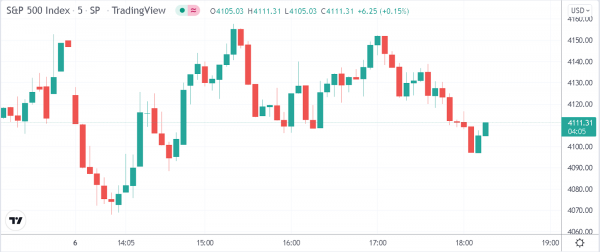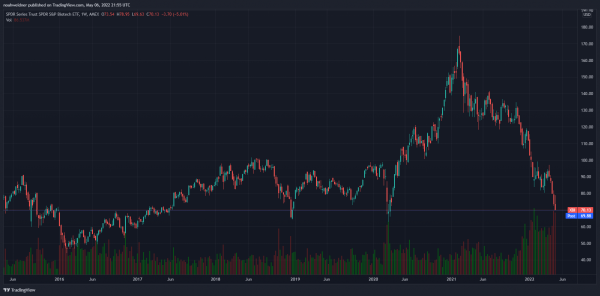Happy Friday, Rip family. Today is May 6, 2022.
Now that the Federal Reserve is taking the liquidity-injection/rate-suppression punch bowl away, volatility is the norm in the markets and unfortunately, unprepared traders are getting chopped up. It’s a trader’s paradise and an investor’s nightmare, but as they say, it is what it is (until it isn’t, that is).

Like the other major market indices, the S&P 500 was directionless today, making sensible investors seasick but yielding sizable premiums for option writers (iykyk). But hey, at least it was better for the bulls than yesterday’s bloodbath.
Outside the index chatter, Under Armour tanked as the sporting goods and apparel retailer posted disappointing first-quarter bottom-line results, while Virgin Galactic shares similarly cratered (though not as deeply as UA and UAA stock) as traders weighed underwhelming earnings and news that Virgin’s commercial flight service is being pushed back again.
On a more positive note (few of which could be found today), Algorand lit up the crypto-sphere when it touched 70 cents, grinding out an algo-tastic 12% gain for the day.

Tron also kept the crypto party going with an 11% pump to 8 cents, as dime-piece dreams captured the imaginations of fans and onlookers throughout Stocktwits’ ever-active Tron stream.
Finally, natural-gas bears finally got a little bit of $KOLD justice as the popular double-leveraged natty-gas short vehicle approached $7, reclaiming some of its staggering recent losses amid an ongoing fossil-fuel revival and persistent geopolitical turmoil. Are those electricity bills heating up, or what?
It was a strange ending to a strange week, but successful traders know to expect the unexpected on Wall Street. Perhaps next week will bring a sense of normalcy back to the markets, if we can even remember what that looks like.
Here’s the closing prints to cap off the day (and week):
| S&P 500 | 4,123 | -0.57% |
| Nasdaq | 12,144 | -1.40% |
| Russell 2000 | 1,839 | -1.69% |
| Dow Jones | 32,899 | -0.30% |
The Bureau of Labor Statistics has released the latest month’s jobs data. It shows that employers added 428,000 positions in April.
We’ve all heard our fair share of “nobody wants to work” over the last year, but these figures show that — although that might be true, maybe some people really don’t want to work — they’re doing so anyway. The U.S. economy is almost back to pre-pandemic employment figures — with over 151.3 million “nonfarm employees.”
That might not sound like an impressive figure, it really is. The unemployment rate sat at 3.6%, just a pinch above its all-time low. In fact, we’re just 0.8% below pre-pandemic employment.
We’d like to call attention to the fact that more than 43% of Americans are under the age of 18 (some of these people work, but more-so are prioritizing education as their main job these days) or on Social Security, which implies that they’re retired (and I hope these people are not working, because they deserve a retirement).
When you consider those two factors, that makes for a very productive-looking economy.
Consider this exciting data amid the other BLS report that came out this week, though: there are more than 11.5 million open jobs right now. According to them, this is “the highest level in the history of the series.” And even with those millions of openings, there were 6.7 million hires made in March 2022. It’s exciting data that investors might wanna take a closer look at, especially given concerns about a forthcoming recession.
Employees made 0.3% more in April 2022, according to the BLS’s average hourly earnings figure, which stood +5.5% YoY. That’s a little bit lower than inflation, which will get an update for the month of April next week, but given the high volume of quits and open jobs, there might be room for wages to go higher.
Market indexes were little-affected by this news today. They all traded down today.
Sponsored
How Does Passion-Based Acquisition Work?
GEGR seeks returns in excess of 35%, using a proprietary model to identify investment opportunities “pre-event,” moving when opportunities become ripe for investment.
From 15 acquisitions, partner companies grossed over $31 million in revenues for the first half of 2021, with $23 million in profit.
Stocks
The Dog Days of Biotech
Compared to others, today’s slate of earnings were relatively paltry — there were just 85 names in the Stocktwits community which were top of mind. However, several of them were biotech companies. Let’s just say that today was a bad day to be a bio.
Ocugen, Intercept Pharmaceuticals, Athersys, Immunogen, and AIM Immunotech ware just a few of the biotech names that were top of mind in the community today. However, their big “earnings day” was overshadowed by the entire bio sector moving lower. In fact, this story isn’t even about those companies at all (sorry to the bulls from these companies above.)
Instead, it’s about underscoring the punishing environment for high risk, growth stocks. Growth bulls know full and well that the last year has been troubling for their portfolios. The risk of higher yields has sent higher risk assets tumbling, and biotech carries a lot of overlap with growth.
Consequently, the SPDR S&P Biotech ETF has been in deep decline. The ETF, which counts many of the industry’s largest bio names among its ranks, fell by -5% today. With that, the index has erased its last five years of gains. We’ve seen some pretty fantastic crashes in terms of valuations, but few compare with this one:

In the Stocktwits trending tickers today, along with our star-studded bio earnings, were Direxion’s Daily S&P Biotech Bull 3X Shares (-15%) and Axsome Therapeutics (-18%.)
China’s renewed COVID-19 lockdowns have wreaked havoc on a number of businesses, including some that you might not typically associate with China. Among the collateral damage this week is sporting goods and apparel retailer Under Armour, as $UA stock took a –25% haircut today, even landing in single-digit territory.
$UA’s Class A cousin, $UAA, was also down more than –20% today. Were the company’s just-released first-quarter 2022 fiscal results really that bad, though?
Put it this way: You know it’s not a good sign when the CEO comes right out with an excuse at the top of the press release. Before trotting through the usual lineup of fiscal stats, Under Armour President and CEO Patrik Frisk cited “global supply challenges and emergent COVID-19 impacts in China” – which, no doubt, were contributing factors to the company’s quarterly performance (or lack thereof, as the case may be).
Q1 was a highly anticipated reporting period given Under Armour’s past few quarters of tribulation in the athletic-wear segment. It’s safe to say, then, that today’s earnings report was make-or-break for the company – and judging by the market’s response, it was more “break” than “make.”
This isn’t to suggest that all of the data was underwhelming. Indeed, Under Armour’s 3% year-over-year revenue improvement could almost be described as halfway decent. However, it’s not an inflation-beating improvement, which means the gain is lost on most investors.
Beyond the revenue growth, however, lurked a slew of startling stats. In a mere three months, Under Armour’s gross margin decreased 350 basis points, while the company’s operating loss totaled $46 million and the net loss amounted to $60 million. As a basis of comparison, in the year-earlier quarter, Under Armour didn’t sustain an operating loss at all, but instead reported operational income of $106.9 million; also during that period, the company recorded net income of $77.8 million rather than a net loss.
In other words, Under Armour managed to swing from impressive income to sizable losses. “Global supply challenges and emergent COVID-19 impacts in China” are punishing many businesses in the U.S., China, and elsewhere, but it’s not hard to see why investors aren’t forgiving Under Armour’s drastic pivot to un-profitability. Hopefully, the company and its shareholders can recover from this – but for today, it’s probably best to keep your expectations low.


